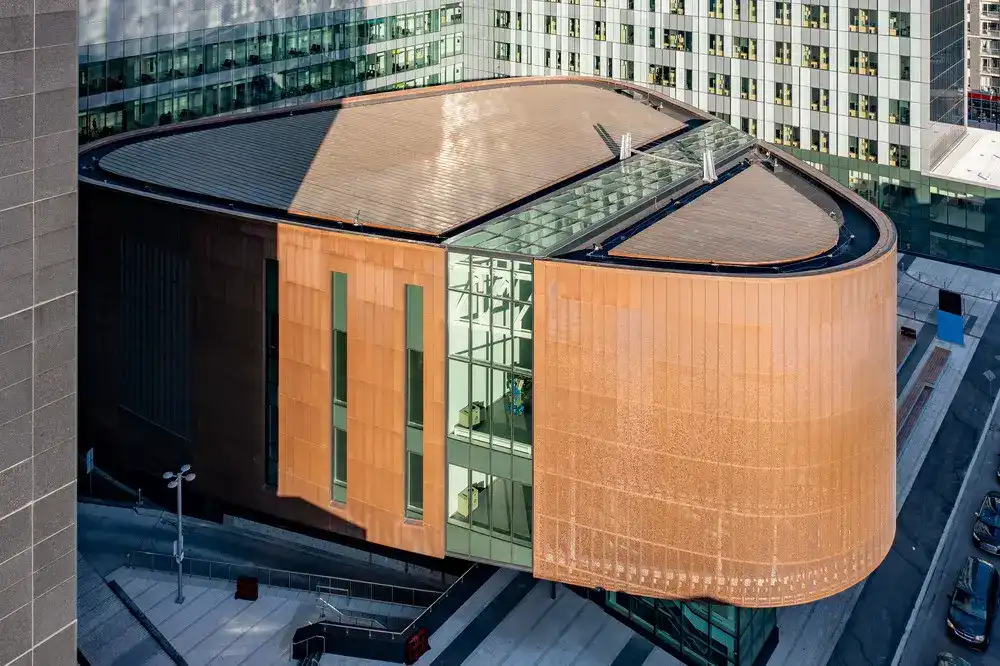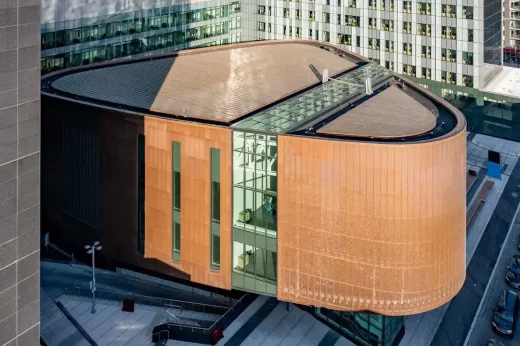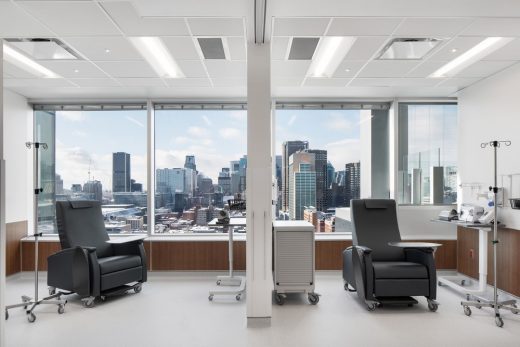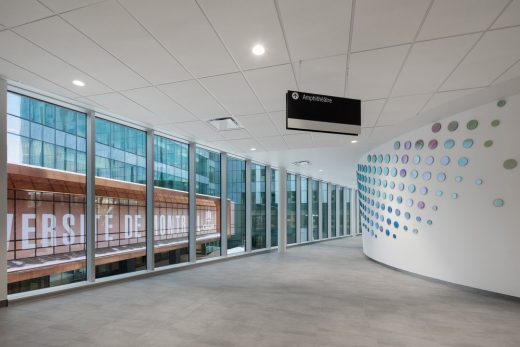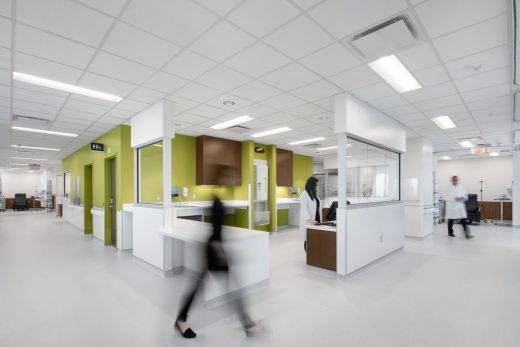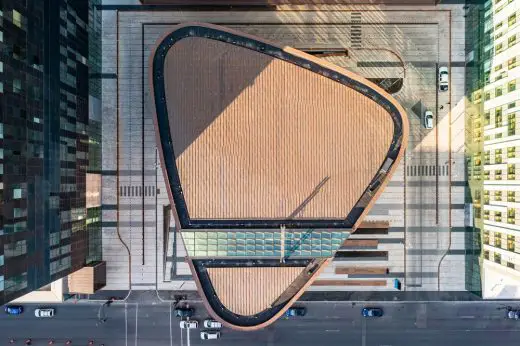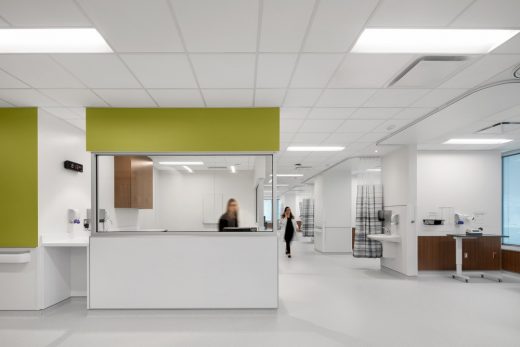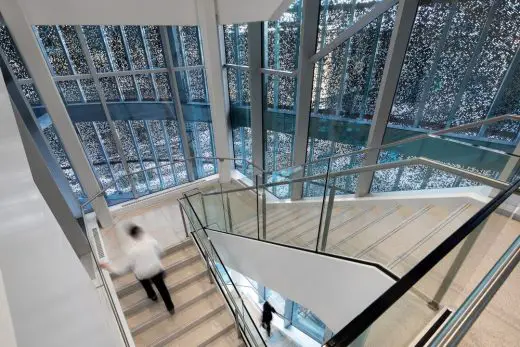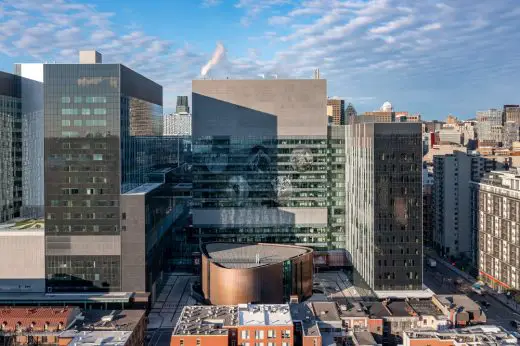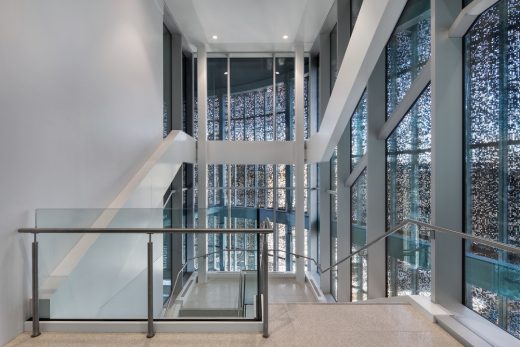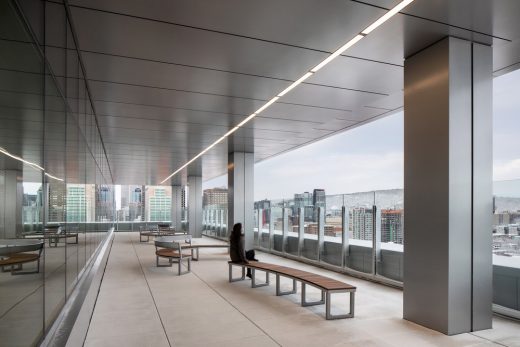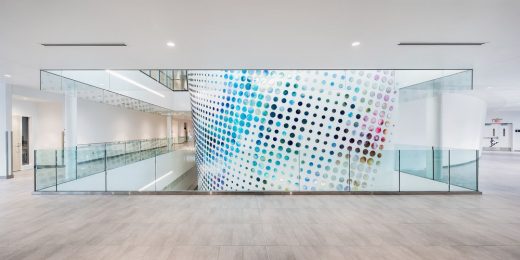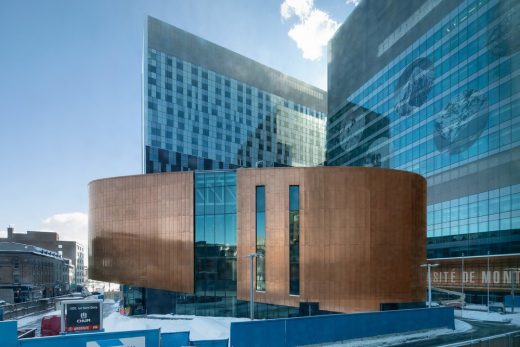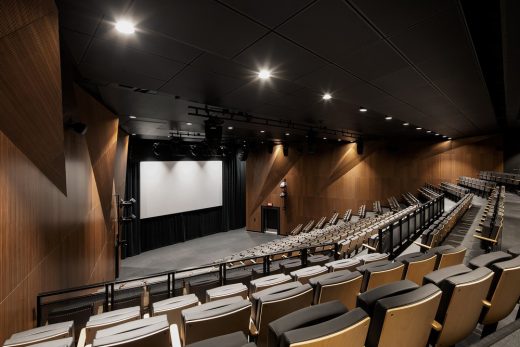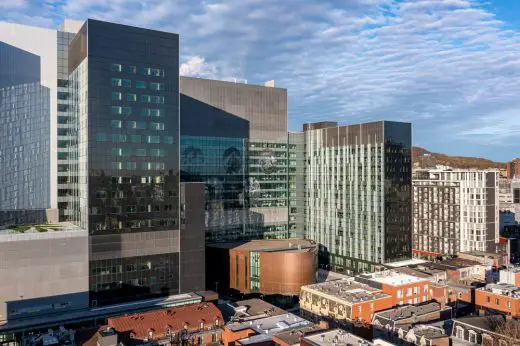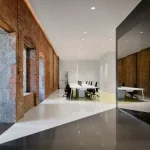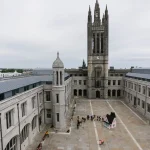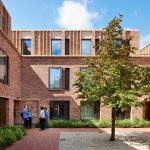Final Phase of New CHUM Completed, Montréal learning facility design, QC building photos
Centre hospitalier de l’Université de Montréal, Montréal in Québec
Architects: Jodoin Lamarre Pratte | Menkès Shooner Dagenais LeTourneux architects in consortium
Location: Montreal, Quebec, Canada
17 Jun 2021
CHUM Downtown Montreal
In 2018, the firms Jodoin Lamarre Pratte architectes and Menkès Shooner Dagenais LeTourneux Architectes were commissioned to complete the final phase of the new Centre hospitalier de l’Université de Montréal (CHUM), erected at the corner of René-Lévesque Boulevard and Saint-Denis Street in downtown Montreal. This latest phase of the project follows those of the Research Centre (2013) and the hospital (2017 – Phase 1) and gives the CHUM the title of one of the most important hospital centres in North America.
Aiming for LEED Silver certification, this new facility integrates the most advanced technologies in the world and creates a care and research environment that puts people at the heart of every activity.
Big Project, Big Challenges
Located in the heart of a busy downtown Montreal quadrangle, the CHUM hospital complex is integrated into a dense urban environment, near the Ville-Marie expressway, a metro station and Montreal’s cosmopolitan and historic districts. “This location presented many challenges,” explains Joanne Parent, architect assistant project manager, and responsible for the quality control of the project.
“First, the hospital had to remain in continuous operation and the work had to be done in such a way as not to compromise the safety of hospital users. Secondly, the excavation and design of the structure had to be such that it would not impose any load on the city’s infrastructure (several underground services) or on Phase 1, nor would it impede traffic flow around the hospital.”
“In fact, the word ‘complex’ probably best defines this project,” says Martine Gévry, responsible for planning the clinical functional units, medical library and offices, specialized equipment, and quality control of interior design. Such a development in a hospital setting involves a multitude of considerations, each more important than the other, including specialized medical equipment, confidentiality requirements, infection control issues, traffic flow and layout efficiency.
“Everything is meticulously analyzed, designed and built to create a care environment that is fully adapted to the activities that take place there, the people who work there and the users who are cared for and accompanied there. If all of this proved to be feasible in this last phase of the CHUM, we must also add the challenges of an efficient and well-thought-out execution in a very cramped street setting, where each movement of manpower or materials requires an almost endless mathematical calculation.
The human being first
This last phase of the CHUM aimed to create an environment capable of welcoming and accompanying users, supporting them through diagnoses, treatments, follow-ups, and visits to their loved ones, in short, a caring environment for patients as well as for the staff who work there every day.
The quality of the spaces has a direct impact on the quality of life of the users, on their feeling of safety and confidence, as well as on the staff and their work experience. Consultations with the various professionals involved led to the development of workspaces and rest areas with plenty of windows, task-adapted lighting and views towards the exterior,” says Ms Parent. Architecture plays an essential role in the planning and functionality of the spaces and routes, which, among other things, reduces the level of stress-related to orientation in a hospital of this size. ”
An assessment of the plans was conducted to understand the frequent critical linkages between the different rooms, clinics, offices… Units were reorganized to optimize floor space and reduce travel distance, allowing medical staff to spend more time with patients. “Based on what had been pre-approved by CHUM during the clinical planning submission (2014), available post-occupancy evaluations, current standards as well as our team’s experience in similar projects,” adds Ms Gévry, “the design of typical and specific spaces, and that of the integrated furniture produced a result which is fully adjusted to the needs of the staff, whether in terms of sequence of use, sensitivity of human contact, ergonomics and robustness, all in consideration of universal accessibility, durability and sustainable development. ”
Pierre-Péladeau Amphitheatre
With its unique and distinctive shape and its envelope made of copper panels, a noble, durable material reminiscent of the roofs of several emblematic institutional buildings in Montreal and elsewhere in Quebec, the Pierre-Péladeau Amphitheatre constitutes the “heart” of the project. The main auditorium, initially designed with fixed bleachers, was redesigned to integrate retractable bleachers.
This large multifunctional auditorium, including varied technological and scenographic equipment, can accommodate 365 people in its standard configuration, while in cabaret mode, it offers nearly 150 seats. The building also houses five modular meeting rooms (the movable walls allow for the configuration of up to 10 meeting rooms), where acoustic is ensured using triple glass.
A veritable structural feat, the building’s volumetry and large spans were achieved through a complex load-bearing frame and cantilevered shell and floors. Integrated above the underground parking lot, surrounded by a perimeter circulation path with access to the parking lot, and equipped with a full-width glass skylight on the roof, this amphitheatre was the source of many functional and technical challenges and required great mastery in both design and execution.
This last phase of the CHUM marks the end of a gigantic urban development project in the health sector. An avant-garde hospital complex where researchers, doctors and specialists join forces to contribute to a better society that takes care of its inhabitants. Once again, architecture has proven to be essential for the realization of a collective societal vision imbued with meaning and human values.
Centre hospitalier de l’Université de Montréal in QC – Building Information
Name of the architect: BGLA
365-seat amphitheatre : 5,582 m2 on 3 floors
Pavilion C – Outpatient Clinics : 15 floors (14,807 m2)
Pavilion B – Library and administrative offices : 15 floors (18,619 m2)
Parking : 852 spaces on 5 floors (31,600 m2) and 210 bicycle spaces
Locker rooms : 3311 lockers for staff (40% of total)
Project team
Finalization of the design, execution, and supervision of the work: Jodoin Lamarre Pratte | Menkès Shooner Dagenais LeTourneux architects in consortium
Design: CannonDesign + NEUF architect(e)s
Lead architect: Michel Broz
Co-project managers: Michel Broz and Anik Shooner, architects
Design direction: Jean-Pierre LeTourneux
Assistant Project Manager, responsible for project quality control and in charge of the production and site teams: Joanne Parent
Person responsible for planning the clinical functional units and workshops, specialized equipment, quality control of interior design and co-responsible for the teams: Martine Gévry
Construction: Pomerleau
Engineering: Pageau Morel and Associates, SDK and Associates
Landscape architecture: NIPpaysage
About Menkès Shooner Dagenais LeTourneux Architects
Menkès Shooner Dagenais LeTourneux Architects has a reputation for excellence in architectural design and recognized experience in the execution of major projects. Bringing together an experienced team of 125 professionals, the firm is known for its agility in carrying out complex projects and for its vivacity in designing creative and innovative architectural responses. Convinced that architectural quality influences our lives, the firm places people at the heart of the projects it designs, aiming for the well-being, health, and quality of life of those who occupy them.
About Jodoin Lamarre Pratte architectes
Jodoin Lamarre Pratte architectes is dedicated its practice to design an architecture that is humane, sustainable, functional and luminous, adapted to its users and integrated into its environment, in the institutional fields of health, transportation, education, research and culture. Recipient of more than 145 awards of excellence and distinctions in architecture, the firm has demonstrated on numerous occasions its ability to design projects of great architectural quality.
Founded in 1958 by Bernard Jodoin, Denis Lamarre and Gérard Pratte, Jodoin Lamarre Pratte architectes now has a team of 145 architects, technicians, designers and other professionals under the direction of Alain Boudrias, Michel Broz, Catherine Demers, Martine Gévry, Sylvain Morrier and Nicolas Ranger.
Photographer: Adrien Williams and Olivier Gariépy
Centre hospitalier de l’Université de Montréal images / information received 170621 from v2com newswire
Location: Montreal, Québec, Canada
Montreal Architecture
Québec Architecture Designs – architectural selection below:
Montreal Architecture Designs – chronological list
Montreal Architecture Walking Tours
Notre Dame College Sports and Cultural Complex, 3791 Queen Mary Road
Architects: ACDF Architecture
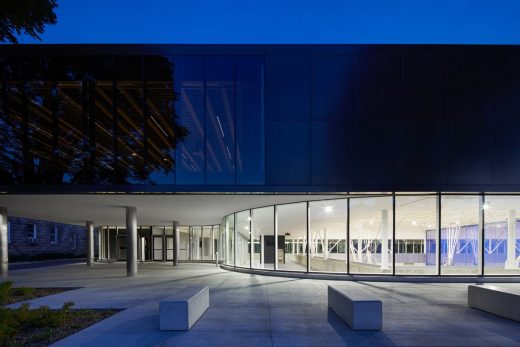
photo : Adrien Williams
Notre Dame College Sports Complex, Montreal
New Vic, McGill University
Design: Diamond Schmitt and Lemay Michaud
The New Vic, Montreal, Canada
Canadian Architectural Designs
Canadian Building Designs – architectural selection below:
Comments / photos for the Centre hospitalier de l’Université de Montréal Canada page welcome

